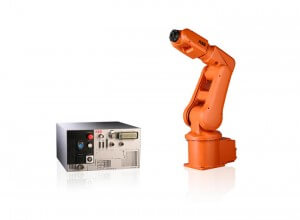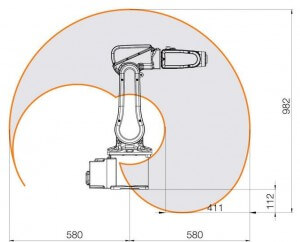
The world of industrial robots has welcomed the next master manipulator, the IRB20. From ABB (NYSE: ABB), the people who brought you the Flexpicker, IRB20 is not only deft, it’s also small. Weighing just 25kg, it still has a reach of more than half a meter and will likely function as an assembly line sorter and assembler. While the IRB20 sounds good on paper, it looks really cool in video. Check out the clip after the break, and I apologize, again, for the robotics industry’s obsession with pairing robot videos with bad techno music.
As robots move firmly into every aspect of manufacturing human concerns are being replaced by engineering restrictions. Look at a human worker and you have to consider experience, salary, and expectations. Look at a robotic worker and you have to consider space, weight, and versatility. In these realms the IRB20 really stands out. It has a small footprint, weighs little, and has a huge range of motion and applications. All that and it looks good dancing (check the video). It’s the robotic equivalent of a recent college graduate eager to please around the office.
Watching the IRB20 glide around glibly on its six axes, I’m struck by the notion that this bot could probably outperform me in about any manual task I’d care to try. The robot takes up very little room (just 180mm X 180mm), can reach 112mm below its base, weighs around 25 kg, and is easily mounted in any position. Human workers have much larger work areas ( > 500mm x 500mm), can sometimes touch their toes, weigh around 70+ kg, and mounting them…ok, let’s not go there. The fact is, that many assembly line workers will look at IRB20 and see their eventual replacement.
Which may or may not be a bad thing for assembly line workers. As robotics take over a large portion of manual manufacturing efficiency will increase, as will profits. More profits at a company generally leads to more jobs. The kinds of manufacturing jobs humans are used for may be changing, but the number of jobs at manufacturing companies may not decline. Growth in service, maintenance, and administration will likely accompany the continuing roboticization of factories.

Of course, no matter their effect on employment, robots are going to continue increasing their dominance in industrial work. ABB has already installed 160,000 robots worldwide, and the IRB20 is poised to be a best seller. Whether you look at the robotic workforce and see increased human leisure time, or can only lament the decline of the human worker, the end results are the same. The future of our economy is going to be a blend of human and robot labor, and the human labor is going to be less manual than it was before. So, for better or worse, let’s welcome the IRB20 to the job. It has some big shoes to fill.


